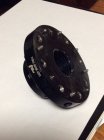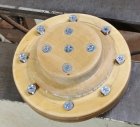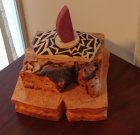A quick story about Amy Grigg's Spike Plate.
Recently my most important customer (my wife Jenn) asked me if I could make a wood plate for a photoshoot the next day. It was 11PM, time for bed, and the plate was due at 10AM the next morning.
Guess who wanted to sleep in and then have a second cup of coffee the next morning?

It wasn't me! I was getting ancy to make the plate, but had to at least make the second cup of coffee before heading down to the shop. I don't remember the exact time, but I had about an hour to make a nice wood plate, and I hadn't even started. The good news: I had a fine piece of doug fir, 5/4 about 12" wide.
I wanted to get the full 1 1/4" of wood for the plate to have a base and be able to pick the plate up easily. After cutting a circle from the piece of fir, the first tool I reached for was the Spike Plate.
I cut a tenon on the back of the plate, turned off the lathe, removed the Spike Plate, and put on a #2 Oneway dovetail chuck. The rim of the plate was so true that I didn't need to touch it with a tool. I sanded the rim beginning at 240...that's how true the plate was...I lost at most a few thousandths of wood. I didn't cut the base, as the original surface was true enough. I put a quick coat of mineral oil on the plate, and off it went to the photoshoot. The plate went into service still with tenon and the nubbin from the live center.
Moral of the story for me: tools get the job done, and when I want efficiency: I invest in tools that increase efficiency. For me: the Spike Plate saves me material, but mostly it save me time and expands the range of a few obscure things I make. I'm not a production turner, but I think like one (at least try to), because this is my livelihood. I'm in the minority here, and so the Spike Plate probably isn't worth the investment for most of you.
I'd also like to address the price of the Spike Plate. It's machined from 6061 Aluminum and is seriously stout. I don't know, but I think it's made in the US. It's a lifetime tool. Green blanks aren't going to rust the Spike Plate. The spikes are replaceable and removable. I felt that it was a bargain because the Spike Plate has paid for itself many times in its first year, and it ought to be around for decades.
EDIT: I'll post a picture of the plate in the gallery.





